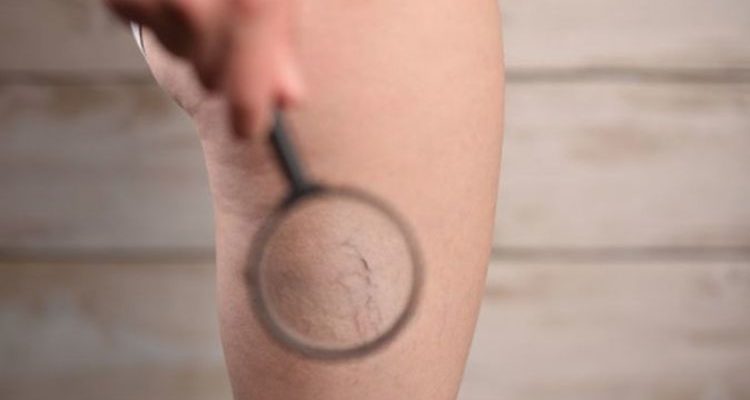Chris Evans discusses the removal of his varicose veins
We use your sign-up to provide content in ways you’ve consented to and to improve our understanding of you. This may include adverts from us and 3rd parties based on our understanding. You can unsubscribe at any time. More info
Varicose veins are just one possible symptom of vein disease, but can you name any more? Probably not. Many Brits often endure the pain and discomfort of varicose veins and vein disease and never seek out a cure, but it’s important to get treated because haemorrhage and other complications from vein issues can lead to sudden death. Express.co.uk chatted to Ed Sideso, Vascular Consultant and Surgeon at UK Vein Clinic to find out the five symptoms of vein disease.
We often neglect our vein health, but veins play a vital part in the circulatory system as they pump deoxygenated blood from your organs back to your heart using their tiny valves.
Vein disease occurs when these valves become damaged or fail, as blood can pool and collect in the vein, causing swelling amongst other issues.
Although often associated with ageing, vein disease can in fact affect anyone, regardless of their age, gender, or underlying health conditions.
Nevertheless, there are certain demographics who are more at risk, including pregnant women and those who spend most of the day on their feet.


The good news is that vein disease is progressive and can be managed through non-invasive treatments.
These treatments can not only improve symptoms but also avoid complications in the future.
Therefore, it’s crucial to identify the signs of vein disease early on to stand the best chance of getting better.
Express.co.uk asked Ed Sideso, Vascular Consultant and Surgeon at UK Vein Clinic to break down the five signs that may indicate you have vein disease.

Prominent Veins
One of the most common early signs of vein disease is that your veins, particularly those on your legs, appear more prominent.
Mr Sideso said: “When the valves in veins become tired or damaged, the blood flowing through them to the heart can flow towards different parts of the body.
“This reduces the amount of blood that is circulating and increases the size of the veins where it is collected.
“These enlarged veins, known as varicose veins, are often more visible against the skin’s surface and appear larger, which can cause feelings of insecurity.”
Heaviness and Aching in Legs
Heaviness and swelling in the leg, especially towards the end of the day, is common for those with vein disease.
This symptom can occur with or without the presence of visually prominent veins.
Mr Sideso said: “Those suffering from vein disease can also frequently experience aching and itchiness around the surrounding area, so a sudden increase in these sensations may be an indicator that your vein health is declining.
“Both heaviness in the leg and prominent veins indicate underlying issues with veins and, if you are affected by both symptoms, then it is likely you have damaged or diseased veins and you should arrange a consultation with your doctor or a vein specialist.
“However, there are also signs that you have a more serious vein disease that requires urgent treatment, or that you have experienced complications after treatment for varicose veins and should seek further help.”
Inflammation of Veins
In addition to being caused by the breakdown of vein walls and damaged valves, inflammation of veins can often be triggered by thrombosis.
Thrombosis is a clot within the veins, and symptoms of inflammation caused by thrombosis include redness of the skin and painful hard lumps underneath the skin.
Mr Sideso said: “Whilst inflammation caused by thrombosis will often reduce, thrombosis can be dangerous, particularly if the blood clot(s) in your vein break loose and get stuck in other parts of the body, such as the lungs, as they travel through your bloodstream.
“Therefore, it’s important to tell your doctor if inflammation occurs, even after treatment for pre-existing varicose veins.”
DON’T MISS…

Bleeding Varicose Veins
Varicose veins are larger and therefore closer to the skin’s surface than non-diseased veins, so they are more vulnerable to impact.
Mr Sideso warned: “If you find that you are bleeding more easily after experiencing impact or knocking something, then this may be a sign that you have vein disease.
“For those who have already identified varicose veins in their body, then bleeding after knocking this vein or the surrounding area indicates that you may require further treatment or complications to the veins may have occurred.”

Changes to Skin
Whilst many of the symptoms associated with vein disease revolve around the appearance and discomfort of varicose veins, vein disorders can manifest in other ways, including in the skin.
Changes to the skin, particularly around your ankle and leg, should be monitored as this can be an indication that you have diseased veins or are at risk of further issues.
Mr Sideso said: “As circulation deteriorates, the skin can start to look shiny, as it thins, whilst it can also become harder and drier, which can lead to the skin cracking.
“The breakdown of skin can cause an ulcer to appear. Ulcers aren’t only painful and uncomfortable, they can be caused by vein disease and put you at risk of infection.”
Source: Read Full Article
